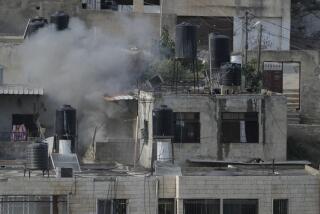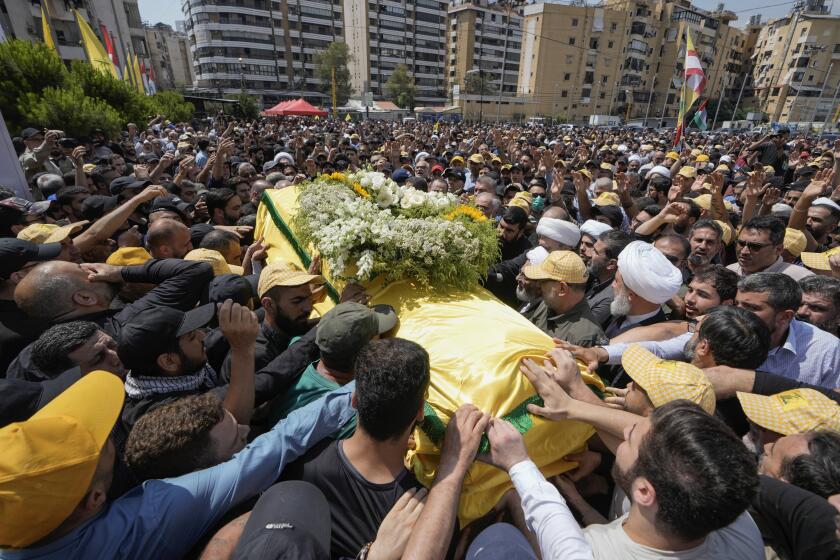Traveling on a Highway of Dread
The route runs through a broad and flat landscape, bare but for a few date palms rising tall and dignified and the occasional small bush. Goats mill about, shepherded by young boys or old men. Except for the litter of plastic bottles and bags, the scene is almost pastoral, peaceful.
It hardly seems the place where people could hide and detonate bombs or jump out and ambush vehicles. But this is Baghdad’s airport road, seven miles of dread.
It was on this road that U.S. soldiers opened fire Friday night on the car carrying Italian journalist Guiliana Sgrena, wounding her and killing the Italian intelligence agent who had negotiated her release from Sunni Muslim insurgents.
Having reported from Iraq for much of the last two years, I was dismayed to hear that a fellow journalist who had survived the unimaginable stress and fear of being a hostage was then the victim of an American military shooting. But when I learned the incident occurred on the airport road, it became, at one level, understandable.
Bad things happen on the airport road -- all the time. Many people who travel it on a regular basis have a personal horror story, a moment when they thought, “This might be it.” Everyone else has a friend who has had one.
Since the war, the airport road has not been any ordinary highway. It is a battleground; a place without rules or certainties, a place where there are no guarantees of safety for civilians or soldiers of any nationality.
For the ordinary traveler, there are two hazards: the wary, short-fused American troops who have lost dozens of their comrades to roadside bombs and ambushes, and the insurgents who target the U.S. military convoys that ply the route.
It is a road to be approached with caution, with a plan, with wariness of every other car and every American convoy.
About five hours before Sgrena was shot, I was on the same road, traveling in the opposite direction from the airport into Baghdad with what has become routine unease. Rather than looking at the scenery, I stared straight ahead and felt a faint nausea.
Many who have traveled the six-lane route have wondered how U.S. and Iraqi forces can ever expect to defeat Iraq’s insurgency if they cannot even make this short stretch of pavement safe. As we drove along, I remembered a conversation I had before the Jan. 30 election with a Western diplomat who had lived in Iraq off and on for a year.
I had asked him if the U.S. military’s goal was to secure more of the country before the vote.
He raised his eyebrows. “The country?” he replied, as if I had asked for the moon. “How about Baghdad? How about just the airport road?”
Most organizations whose employees must travel the route have rules for how to do it. Like most security measures in war zones, they are gospel until the day they don’t work. Some people use armored vehicles and have “chase cars” with armed guards trail them, believing that although they may be conspicuous, at least in an armored car they will survive if insurgents open fire.
Others, wary that armored vehicles might attract the insurgents, will only travel in old Iraqi cars.
No one talks much about the reality that only the heaviest armor, the kind used by the military, can withstand a roadside bomb, and even then not all roadside bombs. Few civilian cars are fitted with that amount of armor.
I travel in an old Iraqi car, and dress in a black gown and head scarf so as not to attract attention. When a military convoy appears, my driver slows to a crawl and waits for it to get at least half a mile ahead before picking up pace again. We fear we might get hit if we get too close and insurgents open fire on the convoy.
As the road slipped by on Friday, I was struck by the calm of the scene, and yet aware of my suspicions. Were the three children playing in the scrub by the side of the road just in need of a playground, or had they been trained to step on a detonator as a U.S. convoy moved by? Was the dead goat stuffed with explosives? Could the quiet neighborhood with hardly a car in sight be hiding insurgents?
“See, that’s where there was an IED,” my driver Ahmad said, using the military’s shorthand for improvised explosive device. “You can see the pit,” he said gesturing to a crater.
He pointed to the charred shell of a car sitting a few feet off the shoulder.
“See that, that’s a bomb car,” he said.
“Last summer I was here, driving from the airport, and suddenly, ‘Boom!’ A Humvee ahead of us was hit. I said, ‘It’s OK, it’s OK’ and then everyone began shooting -- the Americans, the Iraqis over there,” he said, gesturing to the nearby neighborhood.
On this route, it’s hard to know whether a car that speeds by a military convoy simply has a nervous driver, or carries a suicide bomber. Last fall, a bomber on the road targeted an armored bus carrying U.S. personnel. No one was killed, but the bus was damaged. Often passing civilians are injured or die in the attacks.
One of the mosques near the beginning of the route, Ibn Taymiyah, is well known as an insurgent center. When U.S. soldiers searched it, they found grenades, ammunition and guns.
Farther on is a neighborhood named Jihad and another named Furat, where former intelligence officers under Saddam Hussein live.
“Very tough place,” declared Ahmad.
Insurgents hide in the neighborhood and scurry out to lay bombs that can be detonated from a distance with cellphones or garage door openers. Sometimes they shoot from the rooftops of houses.
The military is up against a community that may not like the insurgents but is afraid to turn them in. An Iraqi friend said he has a brother-in-law who lives in Amariya, another neighborhood near the airport, and knows which houses are used by insurgents targeting the road. “I know but I will never tell because they would find out and kill me,” he said.
The Americans have tried to make it difficult for insurgents to operate along the road. They have chopped down palm trees and taken down fences that the rebels hid behind. They have put up observation cameras. They have handed out leaflets and warned people who live in the area not to collaborate with insurgents. But the insurgents keep finding new ways to attack.
On Friday, a military convoy sped by. We stopped, letting it go far ahead. Next we sighted two SUVs that looked like they might be carrying security contractors. Again we slowed, for fear that insurgents might target them.
Suddenly Ahmad sped up, barreling down the rough highway at nearly 80 mph. My worries about insurgents and skittish U.S. soldiers quickly turned to fears of an accident as he honked to get cars to move out of the way.
He believed we were being followed. A burgundy car with three men in it was visible in our rearview mirror, speeding close behind us. We couldn’t tell if they were armed.
Finally, we lost them and slowed down. As we drew up to our hotel, we saw the car again -- it had been the chase car of another news organization. The misplaced suspicion would have been funny, if the situation had not been so dangerous.
The Italians were on the road at a far worse time. Although there are few attacks at night, there is also little visibility, and the U.S. military suspects every vehicle.
Like us, Sgrena must have been frightened of being on the road. But having just escaped from insurgents, she probably never would have thought she would be mistaken for one of them.
More to Read
Sign up for Essential California
The most important California stories and recommendations in your inbox every morning.
You may occasionally receive promotional content from the Los Angeles Times.










